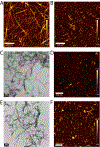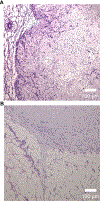In Vitro and in Vivo Analyses of the Effects of Source, Length, and Charge on the Cytotoxicity and Immunocompatibility of Cellulose Nanocrystals
- PMID: 33689287
- PMCID: PMC9147985
- DOI: 10.1021/acsbiomaterials.0c01618
In Vitro and in Vivo Analyses of the Effects of Source, Length, and Charge on the Cytotoxicity and Immunocompatibility of Cellulose Nanocrystals
Abstract
Cellulose nanocrystals (CNCs) are an emergent, sustainable nanomaterial that are biosourced, abundant, and biodegradable. On account of their high aspect ratio, low density, and mechanical rigidity, they have been employed in numerous areas of biomedical research including as reinforcing materials for bone or tissue scaffolds or as carriers in drug delivery systems. Given the promise of these materials for such use, characterizing and understanding their interactions with biological systems is an important step to prevent toxicity or inflammation. Reported herein are studies aimed at exploring the in vitro and in vivo effects that the source, length, and charge of the CNCs have on cytotoxicity and immune response. CNCs from four different biosources (cotton, wood, Miscanthus x Giganteus, and sea tunicate) were prepared and functionalized with positive or negative charges to obtain a small library of CNCs with a range of dimensions and surface charge. A method to remove endotoxic or other impurities on the CNC surface leftover from the isolation process was developed, and the biocompatibility of the CNCs was subsequently assayed in vitro and in vivo. After subcutaneous injection, it was found that unfunctionalized (uncharged) CNCs form aggregates at the site of injection, inducing splenomegaly and neutrophil infiltration, while charged CNCs having surface carboxylates, sulfate half-esters, or primary amines were biologically inert. No effect of the particle source or length was observed in the in vitro and in vivo studies conducted. The lack of an in vitro or in vivo immune response toward charged CNCs in these experiments supports their use in future biological studies.
Keywords: biocompatibility; biomaterials; cellulose nanocrystals; nanomedicine; tissue scaffolds.
Conflict of interest statement
The authors declare the following competing financial interest(s): S.J.R. has an active patent (US10000578B2) on the production of cellulose nanocrystals from
Figures






References
-
- Habibi Y; Lucia LA; Rojas OJ Cellulose nanocrystals: chemistry, self-assembly, and applications. Chem. Rev. 2010, 110 (6), 3479–500. - PubMed
-
- Elazzouzi-Hafraoui S; Nishiyama Y; Putaux JL; Heux L; Dubreuil F; Rochas C The shape and size distribution of crystalline nanoparticles prepared by acid hydrolysis of native cellulose. Biomacromolecules 2008, 9 (1), 57–65. - PubMed
-
- Cheng M; Qin Z; Liu Y; Qin Y; Li T; Chen L; Zhu M Efficient extraction of carboxylated spherical cellulose nanocrystals with narrow distribution through hydrolysis of lyocell fibers by using ammonium persulfate as an oxidant. J. Mater. Chem. A 2014, 2 (1), 251–258.
-
- Calvino C; Macke N; Kato R; Rowan SJ Development, processing and applications of bio-sourced cellulose nanocrystal composites. Prog. Polym. Sci. 2020, 103, 101221.
-
- Mariano M; El Kissi N; Dufresne A Cellulose nanocrystals and related nanocomposites: Review of some properties and challenges. J. Polym. Sci., Part B: Polym. Phys. 2014, 52 (12), 791–806.
Publication types
MeSH terms
Substances
Grants and funding
LinkOut - more resources
Full Text Sources
Other Literature Sources
